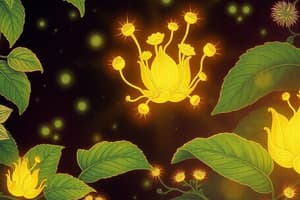Podcast
Questions and Answers
What is photosynthesis?
What is photosynthesis?
- A method of food digestion in animals
- The process of cellular respiration
- The conversion of light energy to chemical energy of food (correct)
- The release of oxygen in plants
What do chloroplasts do?
What do chloroplasts do?
Absorb sunlight and synthesize organic compounds from carbon dioxide and water.
What are thylakoids?
What are thylakoids?
Flattened membrane sacs inside the chloroplast used to convert light energy to chemical energy.
What is the stroma?
What is the stroma?
What are stomata?
What are stomata?
What are the two stages of photosynthesis?
What are the two stages of photosynthesis?
Which of the following statements is a correct distinction between autotrophs and heterotrophs?
Which of the following statements is a correct distinction between autotrophs and heterotrophs?
Which of the following does not occur during the Calvin cycle?
Which of the following does not occur during the Calvin cycle?
What do the light reactions supply the Calvin cycle with?
What do the light reactions supply the Calvin cycle with?
Which of the following equations represents photosynthesis?
Which of the following equations represents photosynthesis?
In which organelle does photosynthesis take place?
In which organelle does photosynthesis take place?
What connects the two photosystems in the light reactions?
What connects the two photosystems in the light reactions?
What are the two molecules produced by the light reactions used to power the Calvin cycle?
What are the two molecules produced by the light reactions used to power the Calvin cycle?
What provides electrons for the light reactions?
What provides electrons for the light reactions?
What transports electrons from the light reactions to the Calvin cycle?
What transports electrons from the light reactions to the Calvin cycle?
Where do the light reactions take place and where does the Calvin cycle occur?
Where do the light reactions take place and where does the Calvin cycle occur?
Where does the Calvin Cycle take place?
Where does the Calvin Cycle take place?
Flashcards are hidden until you start studying
Study Notes
Photosynthesis Overview
- Photosynthesis transforms light energy into chemical energy, primarily stored in glucose.
- Occurs in plants, algae, and some prokaryotes.
Key Organelles
- Chloroplasts: Organelles that absorb sunlight to synthesize organic compounds from CO2 and water.
- Thylakoids: Membrane-bound sacs within chloroplasts, where light energy is converted to chemical energy; organized in stacks called grana.
- Stroma: Fluid surrounding thylakoids in chloroplasts, involved in synthesizing organic molecules from CO2 and water.
Key Molecules and Pigments
- Chlorophyll: Green pigment crucial for absorbing light energy for photosynthesis.
- NADP: An electron acceptor that stores energized electrons from the light reactions as NADPH.
Stages of Photosynthesis
- Light Reactions:
- Occur in thylakoid membranes, convert solar energy into ATP and NADPH, while releasing oxygen.
- Calvin Cycle (Dark Reactions):
- Occurs in the stroma, incorporates CO2 to produce carbohydrates using ATP and NADPH.
Gas Exchange and Nutrient Uptake
- Stomata: Pores on leaves that allow the exchange of gases; O2 exits and CO2 enters.
Chemical Equation of Photosynthesis
- The equation for photosynthesis: 6CO2 + 6H2O → C6H12O6 + 6O2.
Differentiation of Organisms
- Autotrophs: Organisms that can synthesize their own food from inorganic substances (CO2).
- Heterotrophs: Organisms that require organic compounds for nourishment.
Electron Transport and Molecule Production
- Photosystems: Light-capturing units in thylakoid membranes; two types (I and II) absorb light at different wavelengths.
- Electron Transport Chain: Connects two photosystems in light reactions, facilitating electron transfer.
Inputs and Outputs of Photosynthesis
- Light reactions produce ATP and NADPH, utilized in the Calvin Cycle.
- Water (H2O) provides electrons stripped during light reactions.
Carbon Source for Sugars
- Carbon Dioxide (CO2): Source of carbon atoms for sugar molecules in the Calvin cycle; combines with RuBP and regenerates during the cycle.
Location of Reactions
- Light reactions occur in thylakoids; Calvin Cycle takes place in the stroma of chloroplasts.
Studying That Suits You
Use AI to generate personalized quizzes and flashcards to suit your learning preferences.



